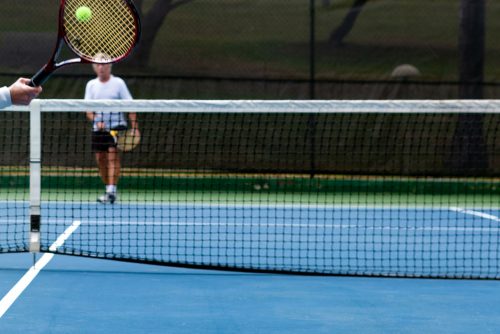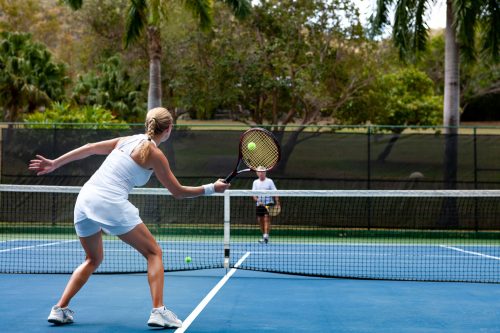Resistance bands can be a great tool to incorporate in your workouts because they are cheap, portable, and allow you to exercise in the comfort of your own home. If you have ever considered using resistance bands in your workouts, you may be wondering whether or not you can target specific muscles with them. For example, can you use resistance bands to grow your glutes? If you have ever found yourself asking this question, then you're in the right place because we have the answer for you!
While other tools or methods may be more effective and produce results faster, you can absolutely grow your glutes with resistance bands. In fact, there are many ways in which using resistance bands to grow your glutes is actually better.
Now that you know you can grow your glutes with resistance bands, you may be tempted to run out, buy them, and get training! However, there are other things to consider when it comes to growing your glutes with resistance bands. How can resistance bands help grow your glutes? What kinds of bands should you buy? Are there better at-home methods to grow your glutes? Read on to find out all these answers and more.

Can You Grow Your Glutes With Resistance Bands?
To answer this question, we should first talk about how muscles are built and can grow. To grow a muscle or a group of muscles, you need to provide your muscles with tension, recovery, and a gradual increase in intensity. Glutes are no different. As long as you provide tension for your glutes, that is to say, provide them with enough stress via workouts, they will grow.
When you use resistance bands to grow your glutes, you are providing your glutes with elastic tension. The more you stretch the band and the higher the resistance is, the more tension will be applied to your glutes. As a result, your glutes will grow as they repair from the stress of the exercise.
How Do Resistance Bands Help Glutes?
Now that you know you can grow your glutes with resistance bands, you may be wondering how to. Using a resistance band to grow your glutes is rather easy because all you have to do is incorporate it into many of your regular workouts.
The first step is choosing the right resistance level. Most resistance bands are grouped by the amount of resistance: extra light, light, medium, heavy, and extra heavy. Choose your resistance level based on your muscle mass, level of fitness, and current glute strength.
Essentially you want your resistance bands to add enough tension and resistance to your glutes that they are being worked past their normal point. This means you should feel the burn and tension in your glutes while you are doing your workouts. It would help if you started lighter and gradually work your way up. Start with fewer repetitions, fewer sets, and a lower amount of resistance. As you feel your workouts are becoming easier, gradually increase the number of sets, the number of reps, the frequency of your workouts, and the duration.
Best Glute Exercises Using Resistance Bands
One of the best exercises to grow glutes using a resistance band is a squat hold. This exercise will have you place the resistance band right above your knees and then lower yourself into a squat. From here, you will open and close your knees. As you do this, the resistance band will provide tension, which will grow your glutes.
Some more great exercises for glutes are squat jumps, crab walks, touch-downs, sidekicks, side to side squats, and donkey kicks. You will position the resistance band above your knees while completing the movements for all of these workouts.
For a guide on these exercises and more, check out this video!
Can You Do Resistance Band Training Every Day?
You can train your glutes every day, but it is important to remember that recovery and rest are necessary for growing muscles. Overworking muscles can result in injury and can actually be detrimental to growing your glutes. In order to ensure the best results, you should aim to work out your glutes 2-3 times a week.
If you are dedicated to working out your glutes every day, you should make sure not to exercise them in the same way every day. Either change up the types of workouts or the intensity. One way to do this is to do heavy glute training 2-3 days a week and then some lighter glute exercises or warmups the rest of the week.
According to most fitness instructors, it is best to have at least one rest day involved in your workout routine, as this is when your muscles will have time to repair themselves and grow. For more information on why rest days are important for growing your glutes, check out this article.
Are Bands Better Than Weights?
Like anything, there are both pros and cons to using bands over free weights. Resistance bands can be very affordable and easy to get. Resistance bands are also a great place for beginners to start because they are less taxing on the body and easier to use. They are easier on the joints and the spine, so they are great for people who may have previous injuries but still want to get a good workout in.
Another pro for resistance bands is that they utilize elastic tension. This means that, unlike free weights, you are not limited by gravitational pull. Free weights always require downward tension, which means you have to work to position your body the right way to target specific muscles. With resistance bands, you can easily work out your glutes from multiple angles without straining yourself.
However, many professional fitness coaches argue that it's hard to measure the amount of resistance a band is offering, which can make it hard to measure your progress. There is also a limit to how much resistance you can go up to. A higher resistance band may be harder to use than a heavier weight of equal tension.
The best method for growing your glutes is to incorporate both free weights (like a kettlebell) and resistance bands into your workout routine. For some exercises utilizing both a resistance band and free weights, click here!
What Can You Use Instead Of A Resistance Band?
There are many at-home tools you can purchase to exercise your glutes besides resistance bands. From small workout machines to free weights, you have many options when it comes to growing your glutes.
One option is a kettlebell free weight. Much like a resistance band, you can use a kettlebell to add tension to exercises like squats, lunges, deadlifts, and hip thrusters.
Click here to check out this kettlebell from Bionic Body on Amazon.
Another great, albeit more expensive option, is to purchase a home machine. There are some more expensive professional looking ones and some smaller, more budget-friendly options to consider. This is perfect if you are looking to grow your glutes easily and efficiently, and will ensure you are targeting the correct muscles.
Check out this glute targeting exercise machine from Superbuy on Amazon.
Click here to see this exercise machine from Sunny Health & Fitness on Amazon.
Another option is a pilates ball or balance trainer to add to exercises like donkey kicks, squats, and lunges. Like a resistance band, this will add extra difficulty and tension to your workouts.
Check out this pilates ball from Trideer on Amazon.
See this balance ball from BOSU on Amazon.
What Resistance Band Should You buy For Glutes?
If you are looking to take the plunge (and a rather cheap plunge at that) into growing your glutes with a resistance band, you may be wondering what the best resistance bands for your glutes are? We have compiled a list of some of the best resistance bands available on the market for you to check out!
Check out these resistance bands from Letsfit on Amazon.
You can find these resistance bands from FREETOO on Amazon.
Click here to see these resistance bands from Fitsimply on Amazon.
Good Luck!
Whatever your fitness level or goals are, we hope this article helped answer your questions about how to grow your glutes with resistance bands. There are many ways to work out, and whatever way is right for you, we wish you a happy work-out and good luck on your fitness journey!
Mix up your exercise routine with Pilates! Check out:
https://fitseer.com/how-much-does-pilates-cost/
Stay tuned-in while you workout, check out:
https://fitseer.com/play-sports-with-airpods/











![Read more about the article Bowling Ball Finger Inserts Or Not? [Pros And Cons Discussed]](https://fitseer.com/wp-content/uploads/2022/05/Close-up-hand-of-woman-is-holding-ball-against-bowling-alley.-500x333.jpg)

